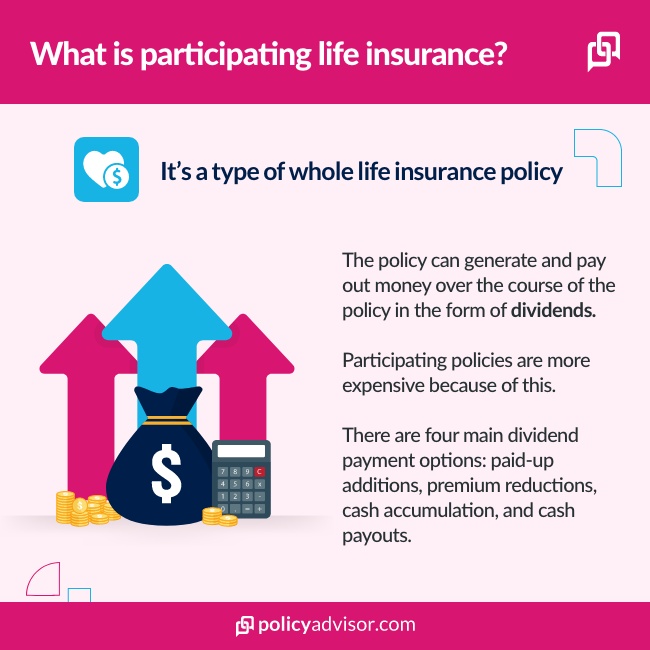What is a participating life insurance policy?
Participating life insurance policies can generate and pay out money over the course of the policy in the form of dividends share by the insurance company managing the funds. However, participating in the policy comes at a greater cost and you share some financial risk with the insurance provider.
Participating life insurance has the potential to pay out more than straight life insurance, but it does so at the cost of greater volatility.
How does participating life insurance work in Canada?
Participating life insurance is a type of whole life insurance policy that—in addition to the guaranteed death benefit—can generate and pay out money over the course of the policy in the form of dividends. These dividends, which are determined by the insurance company’s performance and profits, are typically issued to the policyholder annually. The general idea is that the permanent life insurance policyholder can share in the insurance company’s profits while they are living.
Where do the dividends come from exactly? In short, they come from earnings generated by the premiums that the policyholder pays to the insurance company. Participating policy premiums are pooled and invested by the insurer. The investment income is then used by the insurance company to pay out benefits and other expenses.
The dividends, therefore, come from any surplus profits from the participating investment fund. It should also be noted that dividends are not guaranteed (in contrast to the death benefit) and can fluctuate depending on investment performance.

How much does participating life insurance cost?
Because of the potential for annual investment earnings, participating life insurance is significantly more expensive than term life insurance and standard whole life insurance. In some cases, participating life insurance policyholders can save money in the long term (via dividends and cash value), though again, this is not guaranteed.
As a form of whole life insurance, participating life insurance has fixed premiums, meaning that you pay a fixed rate over the course of your entire policy. In general, whole life insurance has higher premiums than term life insurance because policies lifetime coverage and must therefore account for the added risk of ageing and health issues. The higher cost of participating life insurance makes it well suited for those seeking estate planning solutions in addition to standard life insurance.
Head on over to our life insurance calculator for life insurance needs estimates, or to our instant quote page for whole life insurance quotes.
What are the different types of participating life insurance policies?
Participating life insurance policyholders have a few options when it comes to how their dividends are issued in their life insurance plan. Before we take a closer look at these dividend options it is important to understand how the dividends are calculated.
Every year the insurance provider will calculate the dividend rate by taking a number of factors into account, including investment earnings, expenses, mortality (which influences the amount of benefits paid), and taxes. When investment earnings exceed the expenses, benefits, and taxes, a dividend may be issued to participating insurance holders.
The four main dividend payment options in participating life insurance products
Paid-up additions:
With paid-up additions, policyholders can put their dividends towards purchasing additional coverages which are added to their existing policy. This is a good option for those who want to increase their insurance coverage as well as future dividends. It is also a reliable way to increase your policy’s non-guaranteed cash value. This is also sometimes referred to as additional paid-up insurance.
Premium reduction:
Policyholders can also choose to use their dividends to pay their life insurance premiums (or at least a portion of them). In this case, the dividend would reduce the amount of money owed annually to the insurance provider. Typically, dividends can only be used to reduce premium payments if the policyholder has an annual premium payment plan.
On deposit/Cash accumulation:
In this scenario, the life insurance company simply puts any dividends into an interest-earning account—not unlike a savings account. The interest rate is set on an annual basis by the insurance provider and policyholders can access their dividends whenever needed.
Paid in cash:
Policyholders can choose to receive their dividends as a direct cash payment, which is issued annually by insurance providers. It should be noted that if you choose to receive your dividends as a cash payout, the money may be subject to income tax.
What is the difference between participating policies versus non-participating policies?
When looking at the spectrum of life insurance policy options, there are a number of benefits to participating policies. Still, this doesn’t mean they are the right option for everyone’s life insurance plan. When deciding between participating and non-participating policies there are two main factors to look at: cost and risk.
In terms of cost, we’ve already established that participating policies have higher premiums than straight whole life policies and significantly higher premiums than term life insurance. For those simply seeking to provide a death benefit to their dependents or loved ones with minimal payments, term life insurance is probably the best route. On the other hand, for those looking for an ongoing investment option with fixed premiums and the potential for dividends, participating policies are a good option.
When it comes to risk, non-participating policies are virtually risk-free. You pay premiums to keep your insurance policy active and the insurer takes on most of the risk. With participating policies, however, the risk is shared with policyholders. This can be beneficial when investment earnings are high and expenses are low, but—as with any investment—dividends can fluctuate greatly and are not guaranteed.
All in all, there are pros and cons to any type of life insurance policy. The important thing is to find the right policy type for your needs, whether you are looking for a lower-cost safety net or a more robust investment option.
Why a participating policy may not be for you
Non-participating policies are usually cheaper than participating ones because of the dividend expense. Life insurance providers charge more in order to return the excess dividends to the policyholder. Additionally, there are added tax implications for the policy, as the excess proceeds from the dividends may be considered income.
- Participating life insurance policies are more expensive due to the investment component.
- There are four main dividend payment options are paid-up additions, premium reductions, cash accumulation, and cash payouts.
- Dividends can fluctuate greatly, and some may prefer to invest their money in more stable financial options.


 1-888-601-9980
1-888-601-9980

